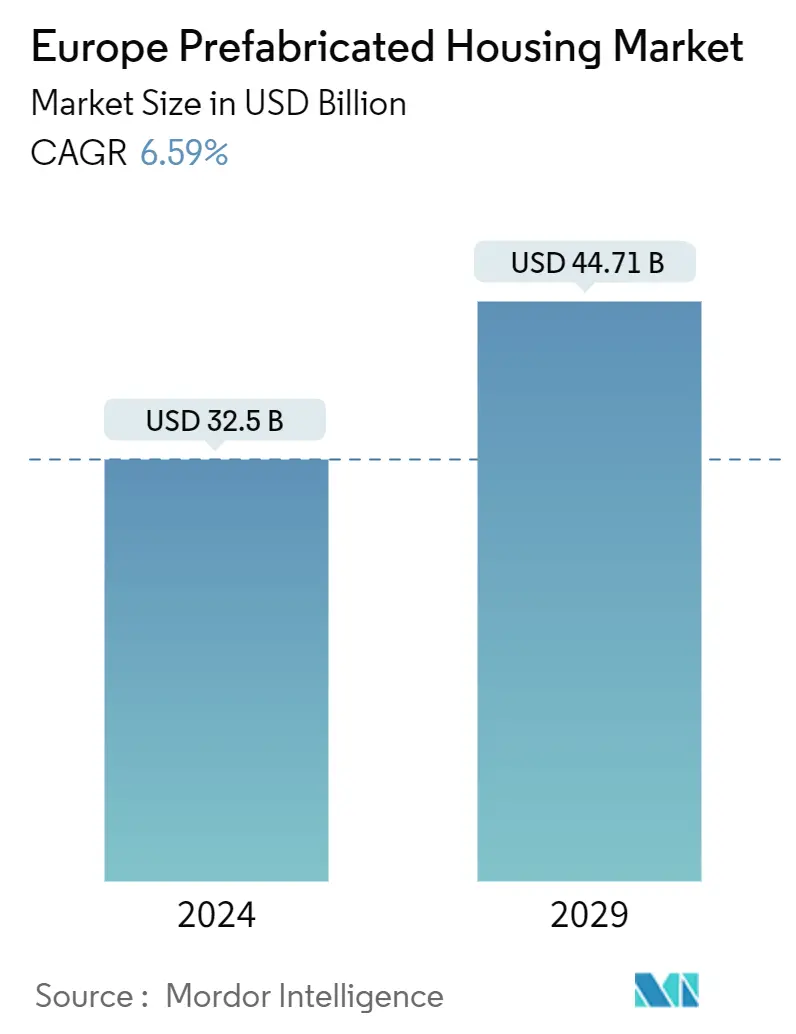Market Size of Europe Prefabricated Housing Industry

| Study Period | 2020 - 2029 |
| Base Year For Estimation | 2023 |
| Market Size (2024) | USD 32.5 Billion |
| Market Size (2029) | USD 44.71 Billion |
| CAGR (2024 - 2029) | 6.59 % |
| Market Concentration | Low |
Major Players
*Disclaimer: Major Players sorted in no particular order |
Need a report that reflects how COVID-19 has impacted this market and its growth?
Europe Prefabricated Housing Market Analysis
The Europe Prefabricated Housing Market size is estimated at USD 32.5 billion in 2024, and is expected to reach USD 44.71 billion by 2029, growing at a CAGR of 6.59% during the forecast period (2024-2029).
The European prefabricated housing market is mainly driven by low- to mid-rise residential buildings, project homes, and public housing demand. The value of the modular construction sector in Poland has increased by almost half over the past two years as prefabricated technology is increasingly used to construct buildings. A large selection of available materials and a rise in raw material prices and labor costs have helped the process.
The construction of the two modules that make up a two-bedroom home takes only 14 days in L&G's factory. Dispatched on the back of lorries and bolted together on site, a house has staircases, windows, doorways, a fully equipped kitchen and bathroom, sockets, radiators, and a heat pump. Modular homes are in the top energy performance bracket, so they could save an average household up to GBP 800 (USD 1013.49) a year on energy bills, according to the industry group Make UK Modular. L&G aims to produce 450 homes at the factory this year but could increase this to 3,000 annually.
Another modular firm, the Goldman Sachs-backed Top Hat company, is creating its second housing site near Corby. It will be the largest 3D modular housing factory in western Europe, the size of 11 football fields. It is planning to build 4,000 homes a year.
According to Make UK Modular, by 2025, the industry will have been able to produce 20,000 prefab homes. The government has set a target of 300,000 new homes annually by 2025, representing a fifth of the 100,000 annual shortfall.
The prefabricated housing market is growing across Europe as people increasingly focus on turnkey solutions that tick all the modern boxes. The manufacturing firms' acceptance and ease of planning and consent processes are expected to boost demand further. Modular construction is gaining popularity across the European region owing to population growth and shortages in housing. It is gaining momentum as an effective means to build affordable housing.
In Italy, the demand for prefabricated, anti-seismic houses in steel is expected to gain popularity, owing to their validity and efficiency in housing safety. It is applicable, especially in those areas subjected to recurrent seismic events. Sweden is one of the world's most developed markets for prefabricated construction, with a high penetration rate.
Sweden is the leading country in implementing penalized building systems, where around 80% of its housing sector uses structures and elements prefabricated in factories. Offsite manufacturing is used in Sweden to build at least 45% of its new homes and 30% of new-build multi-residence buildings. According to an industrial study, about eight out of 10 detached houses in Sweden are built using modern methods.
